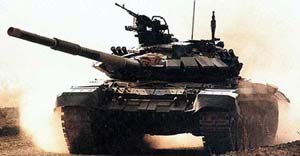
On 17-19 November, the Ministry of Defence of the Russian Federation held a conference of the top commanders of the Russian Armed Forces. The conference was attended by a large number of military leaders, including generals and admirals of the Ministry of Defence and the General Headquarters, Commanders-in-Chief of Armed Services as well as Commanders of Branches, Military Districts and Fleets.
Russia's President Vladimir Putin and Minister of Defence Sergey Ivanov made speeches at the conference. Their speeches summarised the results of military activities in the year 2004 and analysed the main guidelines of development of the Armed Forces up to the year 2016.
After the end of the cold war, the military and political situation in the world became less tense. However, some other alarming processes came into being. There occurs further expansion of globalisation, comprehensive economic and political integration. No matter how progressive these trends might be, they present, however, some negative implications and risks.
Russia is seriously worried about the situation that is developing to the South of the country. These worries are mostly related to the areas of tensions that still exist in the Trans-Caucasian region and in the Central Asia.
The participants of the conference acknowledged that Russia was mostly threatened nowadays by the international terrorism.
That is why the augmented requirements as to the activities of the power-exercising structures, including the Armed Forces, were strengthened by a special attention and comprehensive support coming from the military and political leaders of the country, as well as rhythmical and full-size funding in the framework of the approved budget.
Well under way is the fulfilment of the Federal Special-purpose Programme called 'Transition towards the Manning of Some Military Units with Personnel to Serve under a Contract' intended for the period of 2004-2007. This must result, in particular, in creating preconditions for reduction, from the year 2008, of the conscripts' service in the army down to one year.
The current plans envisage that the 42nd mechanised infantry division, deployed in Chechnya, will have been turned completely to the contract-based service by the end of the year 2000. This division will become a second military unit (after the 76th Air-Borne Division) to be only manned by personnel serving under a contract rather than conscripts. As a result, the Ministry of Defence will completely stop deploying conscripts in Chechnya.
Some information of the numbers losses of the Russian Federation's military units in Chechnya have been unveiled. In 2001, 499 military servicemen were killed, while in 2002 and 2003 this figure decreased down to 480 and 291 respectively. The losses of the Russian Armed Forces in Chechnya during 9 months of the year 2004 amounted to 148 persons.
It has been stated that there are some positive developments in Russia as to the issues of providing the armed forces with weapons and military equipment. This year, the increasing number of both brand new and upgraded military equipment is entering service with the armed forces.
The greater expectations are related to the year 2005. The draft budget for the year 2005 (Article 'National Defence') envisages that 62.8 billion rubles will be spent on research and development in the area of designing promising weapons, 112.3 billion rubles will be spent on procurement of brand new and upgraded military equipment, and 11.8 billion rubles will be spent on repair of weapons and military machines. Along with the maintaining of the nuclear containment forces and the space force on the sufficient level, in the year 2005 the total amount of funding intended for the procurement and repair of military equipment, will include 40 billion rubles for the arms procurement for the Land Forces, and 20 billion rubles for the arms procurement for the Air Force with the same amount intended for the Navy.
Russia will continue to gradually renew the whole of its arsenal by means of modernising it.
In the year 2005, the Russian Land Forces will receive 2 launchers of Iskander-M missile system, 17 T-90 main battle tanks and a quantity of armoured personnel carriers sufficient for equipping 3 battalions (92 BTR-80s).
It is envisaged that the Armed Forces' arms procurement control will be centralised and the procurement order control system will be taken out of the area of responsibilities of the headquarters of the armed services and branches.
At present, the following concepts are being developed: 'Concept of Development of the Armed Forces of the Russian Federation for the Period of up to the Year 2021', 'Conception of Development of the Armed Forces of the Russian Federation for the Period of up to the Year 2016', 'State Programme of Arms Procurement for the Period of up to the Year 2015', 'Federal State Programme of the Quick Equipping of the Russian Federation for the Benefits of the Country's Defence for the Period of up to the Year 2025'.